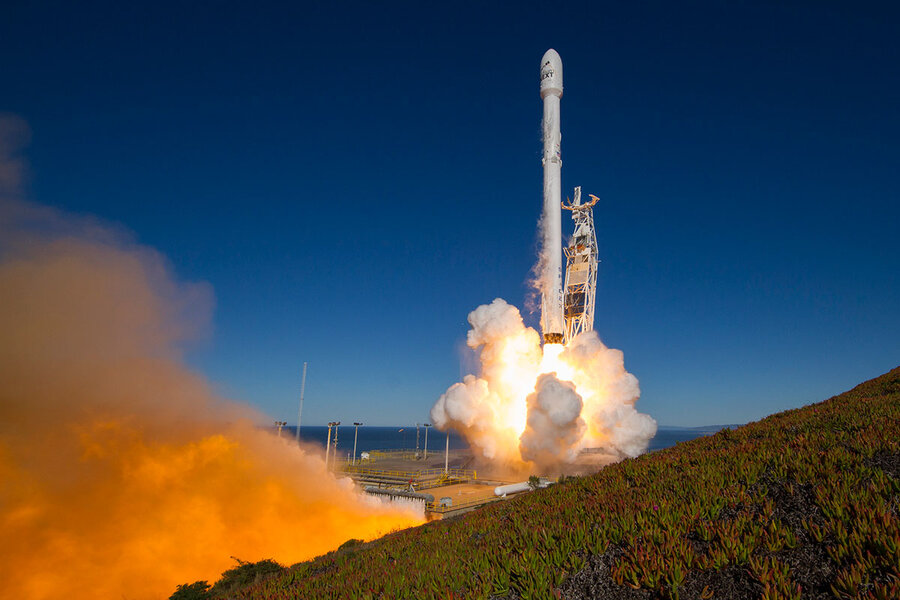SpaceX plans to launch a rocket every two to three weeks. Can they pull it off?
Loading...
SpaceX has another ambitious goal: launch a rocket every two to three weeks.
Space Exploration Technologies Corp. President Gwynne Shotwell told Reuters on Monday that the company plans to follow this ambitious schedule once a new launch pad is put into service in Florida next week. Its old launch pad at Cape Canaveral Air Force Station, also in Florida, was damaged in September when SpaceX’s Falcon 9 rocket burst into flames during a routine preflight test, a mishap that prompted NASA and the US Air Force to raise concerns about the company’s unconventional fueling procedures.
The resumption of its testing program will not only put a backlogged SpaceX back on schedule. Launching a rocket every two to three weeks will also bring SpaceX closer to its goal of dramatically reducing the cost of space travel.
“SpaceX believes a fully and rapidly reusable rocket is the pivotal breakthrough needed to substantially reduce the cost of space access,” reads the company’s website. “A rapidly reusable space launch vehicle could reduce the cost of traveling to space by a hundredfold."
Testing a Falcon 9 rocket every two to three weeks will bring the total tests per year to at least 17. This is more than the 15 annual launches Jefferies International LLC, an investment bank covering telecommunication satellites, estimates will lead to significant savings for SpaceX, as The Christian Science Monitor previously reported.
SpaceX could save over $25 million per launch from their $61 million sticker price, assuming current profit margins of 40 percent, according to a Jefferies report last year which used SpaceX’s public comments to analyze the savings of reusable rockets. But the company's profits could go up to 77 percent per launch, the report suggested, if SpaceX passed along half of its savings to consumers.
SpaceX was on pace to test two to three rocket every week before the pre-flight explosion on Sept. 1. The accident during fueling grounded all the company’s flights while investigators tried to determine why the rocket exploded and how it could have been prevented. Eventually, the investigation determined that a helium tank had ruptured from the extreme cold of liquid nitrogen during fueling, which led to the destruction of the rocket and the Amos-6 communications satellite on board, and damaged the launch pad as well.
SpaceX now has a backlog of more than 70 missions, worth more than $10 billion.
In addition to repairing the launch pad, SpaceX is also modifying the rocket’s engines to increase performance and resolve potential safety concerns, Ms. Shotwell told Reuters. The company plans to change the design of the Falcon 9’s turbopump, which provides propellants to the rocket’s engines, to eliminate cracks, according to Shotwell. Those cracks, she said, raised concerns among NASA and the US Air Force, which has hired SpaceX to taxi astronauts to and from the International Space Station starting in late 2018.
According to Shotwell, NASA and the US Air Force have asked for a redesign to resolve these cracks, which weren’t related to the Sept. 1 explosion.
But officials have also previously criticized SpaceX’s unorthodox fueling procedures, as the Monitor reported this fall:
SpaceX employs a different fueling strategy than other companies: It uses chilled liquid oxygen in order to be able to fit more fuel in the tank and lift more weight into orbit, an innovative step that has allowed SpaceX to break new ground in cargo carriage. But because of this special fueling method, its spacecraft must be fueled immediately before launch so that the fuel does not warm up, which means that in the future, astronauts will likely be aboard prior to fueling.
Spaceflight officials have raised concerns about fueling conditions for some time. In December 2015, International Space Station advisory committee Chairman Lt. Gen. Thomas Stafford told NASA in a letter that fueling a rocket with crew aboard flies in the face of decades of launch policies.
Analysts also question SpaceX’s ability to recycle first-stage rockets.
“There are ongoing challenges in translating a reused rocket to tangible [capital expenditure] savings – worries about it failing, insurance implications, retrofitting turnaround, building up a critical mass of reused first stages in the warehouse,” Jefferies wrote in its report.
Besides the increased costs in insurance, testing, and refurbishing, landing a rocket designed for reuse takes as much as 30 percent more propellant, according to French space agency CNES.
But SpaceX hopes to silence its critics in March, when it plans to re-launch a rocket for the first time. On this recycled, first-stage booster, SpaceX plans to send a satellite for communications company SES into orbit.
This report includes material from Reuters.







